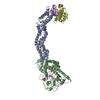+ Open data
Open data
- Basic information
Basic information
| Entry | Database: PDB / ID: 6wcq | ||||||
|---|---|---|---|---|---|---|---|
| Title | Structure of a substrate-bound DQC ubiquitin ligase | ||||||
 Components Components |
| ||||||
 Keywords Keywords |  LIGASE / LIGASE /  ubiquitin / E3-ligase / ubiquitin / E3-ligase /  multiprotein complex / substrate recognition multiprotein complex / substrate recognition | ||||||
| Function / homology |  Function and homology information Function and homology informationParkin-FBXW7-Cul1 ubiquitin ligase complex /  F-box domain binding / negative regulation of response to oxidative stress / PcG protein complex / regulation of epidermal cell differentiation / cullin-RING ubiquitin ligase complex / Cul7-RING ubiquitin ligase complex / positive regulation of ubiquitin protein ligase activity / Loss of Function of FBXW7 in Cancer and NOTCH1 Signaling / maintenance of protein location in nucleus ...Parkin-FBXW7-Cul1 ubiquitin ligase complex / F-box domain binding / negative regulation of response to oxidative stress / PcG protein complex / regulation of epidermal cell differentiation / cullin-RING ubiquitin ligase complex / Cul7-RING ubiquitin ligase complex / positive regulation of ubiquitin protein ligase activity / Loss of Function of FBXW7 in Cancer and NOTCH1 Signaling / maintenance of protein location in nucleus ...Parkin-FBXW7-Cul1 ubiquitin ligase complex /  F-box domain binding / negative regulation of response to oxidative stress / PcG protein complex / regulation of epidermal cell differentiation / cullin-RING ubiquitin ligase complex / Cul7-RING ubiquitin ligase complex / positive regulation of ubiquitin protein ligase activity / Loss of Function of FBXW7 in Cancer and NOTCH1 Signaling / maintenance of protein location in nucleus / regulation of smoothened signaling pathway / neural crest cell differentiation / Nuclear events mediated by NFE2L2 / F-box domain binding / negative regulation of response to oxidative stress / PcG protein complex / regulation of epidermal cell differentiation / cullin-RING ubiquitin ligase complex / Cul7-RING ubiquitin ligase complex / positive regulation of ubiquitin protein ligase activity / Loss of Function of FBXW7 in Cancer and NOTCH1 Signaling / maintenance of protein location in nucleus / regulation of smoothened signaling pathway / neural crest cell differentiation / Nuclear events mediated by NFE2L2 /  SCF ubiquitin ligase complex / ubiquitin ligase complex scaffold activity / SCF-dependent proteasomal ubiquitin-dependent protein catabolic process / Cul3-RING ubiquitin ligase complex / protein quality control for misfolded or incompletely synthesized proteins / Prolactin receptor signaling / entrainment of circadian clock by photoperiod / protein monoubiquitination / cullin family protein binding / centriolar satellite / ubiquitin-like ligase-substrate adaptor activity / cellular response to interleukin-4 / Nuclear events stimulated by ALK signaling in cancer / protein K48-linked ubiquitination / SCF ubiquitin ligase complex / ubiquitin ligase complex scaffold activity / SCF-dependent proteasomal ubiquitin-dependent protein catabolic process / Cul3-RING ubiquitin ligase complex / protein quality control for misfolded or incompletely synthesized proteins / Prolactin receptor signaling / entrainment of circadian clock by photoperiod / protein monoubiquitination / cullin family protein binding / centriolar satellite / ubiquitin-like ligase-substrate adaptor activity / cellular response to interleukin-4 / Nuclear events stimulated by ALK signaling in cancer / protein K48-linked ubiquitination /  inclusion body / inclusion body /  Regulation of BACH1 activity / MAP3K8 (TPL2)-dependent MAPK1/3 activation / intrinsic apoptotic signaling pathway / SCF-beta-TrCP mediated degradation of Emi1 / NIK-->noncanonical NF-kB signaling / Regulation of BACH1 activity / MAP3K8 (TPL2)-dependent MAPK1/3 activation / intrinsic apoptotic signaling pathway / SCF-beta-TrCP mediated degradation of Emi1 / NIK-->noncanonical NF-kB signaling /  regulation of autophagy / molecular function activator activity / Vpu mediated degradation of CD4 / regulation of autophagy / molecular function activator activity / Vpu mediated degradation of CD4 /  actin filament / Dectin-1 mediated noncanonical NF-kB signaling / Degradation of GLI1 by the proteasome / Activation of NF-kappaB in B cells / Negative regulation of NOTCH4 signaling / animal organ morphogenesis / Iron uptake and transport / GSK3B and BTRC:CUL1-mediated-degradation of NFE2L2 / Degradation of GLI2 by the proteasome / GLI3 is processed to GLI3R by the proteasome / FBXL7 down-regulates AURKA during mitotic entry and in early mitosis / Degradation of beta-catenin by the destruction complex / negative regulation of DNA-binding transcription factor activity / G1/S transition of mitotic cell cycle / NOTCH1 Intracellular Domain Regulates Transcription / CLEC7A (Dectin-1) signaling / SCF(Skp2)-mediated degradation of p27/p21 / actin filament / Dectin-1 mediated noncanonical NF-kB signaling / Degradation of GLI1 by the proteasome / Activation of NF-kappaB in B cells / Negative regulation of NOTCH4 signaling / animal organ morphogenesis / Iron uptake and transport / GSK3B and BTRC:CUL1-mediated-degradation of NFE2L2 / Degradation of GLI2 by the proteasome / GLI3 is processed to GLI3R by the proteasome / FBXL7 down-regulates AURKA during mitotic entry and in early mitosis / Degradation of beta-catenin by the destruction complex / negative regulation of DNA-binding transcription factor activity / G1/S transition of mitotic cell cycle / NOTCH1 Intracellular Domain Regulates Transcription / CLEC7A (Dectin-1) signaling / SCF(Skp2)-mediated degradation of p27/p21 /  beta-catenin binding / Constitutive Signaling by NOTCH1 PEST Domain Mutants / Constitutive Signaling by NOTCH1 HD+PEST Domain Mutants / FCERI mediated NF-kB activation / Interleukin-1 signaling / Orc1 removal from chromatin / protein polyubiquitination / Regulation of RUNX2 expression and activity / Cyclin D associated events in G1 / KEAP1-NFE2L2 pathway / beta-catenin binding / Constitutive Signaling by NOTCH1 PEST Domain Mutants / Constitutive Signaling by NOTCH1 HD+PEST Domain Mutants / FCERI mediated NF-kB activation / Interleukin-1 signaling / Orc1 removal from chromatin / protein polyubiquitination / Regulation of RUNX2 expression and activity / Cyclin D associated events in G1 / KEAP1-NFE2L2 pathway /  Regulation of PLK1 Activity at G2/M Transition / disordered domain specific binding / Regulation of PLK1 Activity at G2/M Transition / disordered domain specific binding /  Circadian Clock / positive regulation of proteasomal ubiquitin-dependent protein catabolic process / Antigen processing: Ubiquitination & Proteasome degradation / Downstream TCR signaling / protein-macromolecule adaptor activity / Circadian Clock / positive regulation of proteasomal ubiquitin-dependent protein catabolic process / Antigen processing: Ubiquitination & Proteasome degradation / Downstream TCR signaling / protein-macromolecule adaptor activity /  nervous system development / nervous system development /  Neddylation / mitotic cell cycle / cellular response to oxidative stress / midbody / ubiquitin-dependent protein catabolic process / proteasome-mediated ubiquitin-dependent protein catabolic process / positive regulation of canonical NF-kappaB signal transduction / in utero embryonic development / RNA polymerase II-specific DNA-binding transcription factor binding / cell population proliferation / Potential therapeutics for SARS / Ub-specific processing proteases / protein ubiquitination / Neddylation / mitotic cell cycle / cellular response to oxidative stress / midbody / ubiquitin-dependent protein catabolic process / proteasome-mediated ubiquitin-dependent protein catabolic process / positive regulation of canonical NF-kappaB signal transduction / in utero embryonic development / RNA polymerase II-specific DNA-binding transcription factor binding / cell population proliferation / Potential therapeutics for SARS / Ub-specific processing proteases / protein ubiquitination /  chromatin remodeling / protein domain specific binding / chromatin remodeling / protein domain specific binding /  centrosome / centrosome /  ubiquitin protein ligase binding / ubiquitin protein ligase binding /  endoplasmic reticulum / endoplasmic reticulum /  nucleoplasm / identical protein binding / nucleoplasm / identical protein binding /  nucleus / nucleus /  plasma membrane / plasma membrane /  cytosol / cytosol /  cytoplasm cytoplasmSimilarity search - Function | ||||||
| Biological species |   Homo sapiens (human) Homo sapiens (human) | ||||||
| Method |  ELECTRON MICROSCOPY / ELECTRON MICROSCOPY /  single particle reconstruction / single particle reconstruction /  cryo EM / Resolution: 8.5 Å cryo EM / Resolution: 8.5 Å | ||||||
 Authors Authors | Mena, E.L. / Jevtic, P. / Greber, B.J. / Gee, C.L. / Lew, B.G. / Akopian, D. / Nogales, E. / Kuriyan, J. / Rape, M. | ||||||
| Funding support |  United States, 1items United States, 1items
| ||||||
 Citation Citation |  Journal: Nature / Year: 2020 Journal: Nature / Year: 2020Title: Structural basis for dimerization quality control. Authors: Elijah L Mena / Predrag Jevtić / Basil J Greber / Christine L Gee / Brandon G Lew / David Akopian / Eva Nogales / John Kuriyan / Michael Rape /  Abstract: Most quality control pathways target misfolded proteins to prevent toxic aggregation and neurodegeneration. Dimerization quality control further improves proteostasis by eliminating complexes of ...Most quality control pathways target misfolded proteins to prevent toxic aggregation and neurodegeneration. Dimerization quality control further improves proteostasis by eliminating complexes of aberrant composition, but how it detects incorrect subunits remains unknown. Here we provide structural insight into target selection by SCF-FBXL17, a dimerization-quality-control E3 ligase that ubiquitylates and helps to degrade inactive heterodimers of BTB proteins while sparing functional homodimers. We find that SCF-FBXL17 disrupts aberrant BTB dimers that fail to stabilize an intermolecular β-sheet around a highly divergent β-strand of the BTB domain. Complex dissociation allows SCF-FBXL17 to wrap around a single BTB domain, resulting in robust ubiquitylation. SCF-FBXL17 therefore probes both shape and complementarity of BTB domains, a mechanism that is well suited to establish quality control of complex composition for recurrent interaction modules. | ||||||
| History |
|
- Structure visualization
Structure visualization
| Movie |
 Movie viewer Movie viewer |
|---|---|
| Structure viewer | Molecule:  Molmil Molmil Jmol/JSmol Jmol/JSmol |
- Downloads & links
Downloads & links
- Download
Download
| PDBx/mmCIF format |  6wcq.cif.gz 6wcq.cif.gz | 201.9 KB | Display |  PDBx/mmCIF format PDBx/mmCIF format |
|---|---|---|---|---|
| PDB format |  pdb6wcq.ent.gz pdb6wcq.ent.gz | 144.8 KB | Display |  PDB format PDB format |
| PDBx/mmJSON format |  6wcq.json.gz 6wcq.json.gz | Tree view |  PDBx/mmJSON format PDBx/mmJSON format | |
| Others |  Other downloads Other downloads |
-Validation report
| Arichive directory |  https://data.pdbj.org/pub/pdb/validation_reports/wc/6wcq https://data.pdbj.org/pub/pdb/validation_reports/wc/6wcq ftp://data.pdbj.org/pub/pdb/validation_reports/wc/6wcq ftp://data.pdbj.org/pub/pdb/validation_reports/wc/6wcq | HTTPS FTP |
|---|
-Related structure data
| Related structure data |  21617MC  6w66C 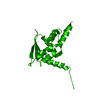 6w67C 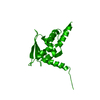 6w68C 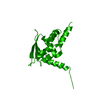 6w69C C: citing same article ( M: map data used to model this data |
|---|---|
| Similar structure data |
- Links
Links
- Assembly
Assembly
| Deposited unit | 
|
|---|---|
| 1 |
|
- Components
Components
| #1: Protein |  / SKP1 / Cyclin-A/CDK2-associated protein p19 / p19A / Organ of Corti protein 2 / OCP-2 / Organ of ...SKP1 / Cyclin-A/CDK2-associated protein p19 / p19A / Organ of Corti protein 2 / OCP-2 / Organ of Corti protein II / OCP-II / RNA polymerase II elongation factor-like protein / SIII / Transcription elongation factor B polypeptide 1-like / p19skp1 / SKP1 / Cyclin-A/CDK2-associated protein p19 / p19A / Organ of Corti protein 2 / OCP-2 / Organ of ...SKP1 / Cyclin-A/CDK2-associated protein p19 / p19A / Organ of Corti protein 2 / OCP-2 / Organ of Corti protein II / OCP-II / RNA polymerase II elongation factor-like protein / SIII / Transcription elongation factor B polypeptide 1-like / p19skp1Mass: 18679.965 Da / Num. of mol.: 1 Source method: isolated from a genetically manipulated source Source: (gene. exp.)   Homo sapiens (human) / Gene: SKP1, EMC19, OCP2, SKP1A, TCEB1L / Production host: Homo sapiens (human) / Gene: SKP1, EMC19, OCP2, SKP1A, TCEB1L / Production host:   Trichoplusia ni (cabbage looper) / References: UniProt: P63208 Trichoplusia ni (cabbage looper) / References: UniProt: P63208 |
|---|---|
| #2: Protein | Mass: 44970.043 Da / Num. of mol.: 1 Source method: isolated from a genetically manipulated source Source: (gene. exp.)   Homo sapiens (human) / Gene: FBXL17, FBL17, FBX13, FBXO13 / Production host: Homo sapiens (human) / Gene: FBXL17, FBL17, FBX13, FBXO13 / Production host:   Trichoplusia ni (cabbage looper) / References: UniProt: Q9UF56 Trichoplusia ni (cabbage looper) / References: UniProt: Q9UF56 |
| #3: Protein | Mass: 70173.484 Da / Num. of mol.: 1 / Mutation: V99A Source method: isolated from a genetically manipulated source Source: (gene. exp.)   Homo sapiens (human) / Gene: KEAP1, INRF2, KIAA0132, KLHL19 / Production host: Homo sapiens (human) / Gene: KEAP1, INRF2, KIAA0132, KLHL19 / Production host:   Trichoplusia ni (cabbage looper) / References: UniProt: Q14145 Trichoplusia ni (cabbage looper) / References: UniProt: Q14145 |
| #4: Protein |  / CUL-1 / CUL-1Mass: 49926.520 Da / Num. of mol.: 1 / Fragment: residues 1-434 Source method: isolated from a genetically manipulated source Source: (gene. exp.)   Homo sapiens (human) / Gene: CUL1 / Production host: Homo sapiens (human) / Gene: CUL1 / Production host:   Trichoplusia ni (cabbage looper) / References: UniProt: Q13616 Trichoplusia ni (cabbage looper) / References: UniProt: Q13616 |
-Experimental details
-Experiment
| Experiment | Method:  ELECTRON MICROSCOPY ELECTRON MICROSCOPY |
|---|---|
| EM experiment | Aggregation state: PARTICLE / 3D reconstruction method:  single particle reconstruction single particle reconstruction |
- Sample preparation
Sample preparation
| Component | Name: CUL1-SKP1-FBXL17-KEAP1 complex / Type: COMPLEX / Entity ID: all / Source: RECOMBINANT | |||||||||||||||||||||||||||||||||||
|---|---|---|---|---|---|---|---|---|---|---|---|---|---|---|---|---|---|---|---|---|---|---|---|---|---|---|---|---|---|---|---|---|---|---|---|---|
| Molecular weight | Experimental value: NO | |||||||||||||||||||||||||||||||||||
| Source (natural) | Organism:   Homo sapiens (human) Homo sapiens (human) | |||||||||||||||||||||||||||||||||||
| Source (recombinant) | Organism:   Trichoplusia ni (cabbage looper) Trichoplusia ni (cabbage looper) | |||||||||||||||||||||||||||||||||||
| Buffer solution |
| |||||||||||||||||||||||||||||||||||
| Buffer component |
| |||||||||||||||||||||||||||||||||||
| Specimen |
| |||||||||||||||||||||||||||||||||||
| Specimen support |
| |||||||||||||||||||||||||||||||||||
Vitrification |
|
- Electron microscopy imaging
Electron microscopy imaging
| Experimental equipment |  Model: Talos Arctica / Image courtesy: FEI Company | ||||||||||||||||||
|---|---|---|---|---|---|---|---|---|---|---|---|---|---|---|---|---|---|---|---|
| EM imaging | Accelerating voltage: 200 kV / Alignment procedure: COMA FREE / C2 aperture diameter: 50 µm / Cryogen: NITROGEN / Electron source
| ||||||||||||||||||
| Image recording |
|
- Processing
Processing
| Software | Name: PHENIX / Version: 1.16_3549: / Classification: refinement | ||||||||||||||||||||||||||||||||||||||||||||||||||||||||||||||||||
|---|---|---|---|---|---|---|---|---|---|---|---|---|---|---|---|---|---|---|---|---|---|---|---|---|---|---|---|---|---|---|---|---|---|---|---|---|---|---|---|---|---|---|---|---|---|---|---|---|---|---|---|---|---|---|---|---|---|---|---|---|---|---|---|---|---|---|---|
| EM software |
| ||||||||||||||||||||||||||||||||||||||||||||||||||||||||||||||||||
| Image processing | Details: Datasets from K3 and K2 were joined for the final reconstruction. | ||||||||||||||||||||||||||||||||||||||||||||||||||||||||||||||||||
CTF correction | Details: As implemented in RELION. / Type: PHASE FLIPPING AND AMPLITUDE CORRECTION | ||||||||||||||||||||||||||||||||||||||||||||||||||||||||||||||||||
| Particle selection | Num. of particles selected: 824561 Details: Total number of particles for both datasets. Selected using RELION auto-picking (Laplacian-of-Gaussian). | ||||||||||||||||||||||||||||||||||||||||||||||||||||||||||||||||||
| Symmetry | Point symmetry : C1 (asymmetric) : C1 (asymmetric) | ||||||||||||||||||||||||||||||||||||||||||||||||||||||||||||||||||
3D reconstruction | Resolution: 8.5 Å / Resolution method: FSC 0.143 CUT-OFF / Num. of particles: 160256 / Algorithm: FOURIER SPACE / Num. of class averages: 2 / Symmetry type: POINT | ||||||||||||||||||||||||||||||||||||||||||||||||||||||||||||||||||
| Atomic model building | Protocol: OTHER / Space: REAL Details: Coordinates were fitted as rigid bodies or fragments in Chimera and subsequently geometry-optimized using PHENIX real space refinement. | ||||||||||||||||||||||||||||||||||||||||||||||||||||||||||||||||||
| Atomic model building |
| ||||||||||||||||||||||||||||||||||||||||||||||||||||||||||||||||||
| Refine LS restraints |
|
 Movie
Movie Controller
Controller







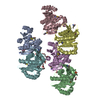


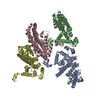
 PDBj
PDBj













